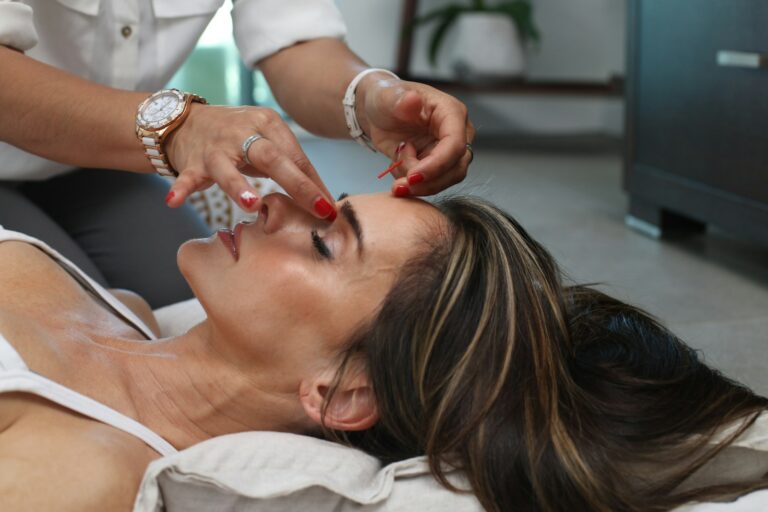Table of Contents
ToggleImportant Questions About Facial Cleansing
Explore 11 crucial questions about facial cleansing answered by a cosmetic doctor. Understand the benefits, methods, and considerations for achieving optimal skin health through professional skincare practices.
Is facial cleansing really necessary? And is it solely for the purpose of beauty?
Milk, toners, and other cosmetic products only remove surface impurities, leaving some of the dead skin cells on the skin’s surface. Pores are not completely cleansed, gradually becoming clogged and leading to the appearance of blackheads, inflammation, and pustules. This problem is particularly relevant for people with oily, problematic, and sensitive skin.
Achieving deep cleansing from dirt, sebum, and dead cells is aided by professional facial cleansing.
The procedure addresses several objectives:
- Removal of fine particles of dirt and dead epidermal cells.
- Slowing down the formation of sebum.
- Tightening enlarged pores.
- Removing blackheads, open and closed comedones.
Facial cleansing falls under hygiene procedures but also serves an aesthetic function. Afterward, the complexion improves, the skin becomes even, smooth, and radiant. Additionally, cleansed tissues better absorb home and professional care cosmetic products. The components penetrate the dermis more deeply and act more effectively.
How to know when it’s time for cleansing? And can anyone perform it?
It is advisable to entrust professional facial cleansing to a specialist with a medical background in a medical facility.
When is cleansing necessary?
Common indications for facial cleansing include:
- Enlarged, noticeable pores.
- Acne rash.
- Blackheads (comedones).
- Increased activity of sebaceous glands.
- Unhealthy, dull skin tone.
- Loss of elasticity.
The choice of methodology depends on the indications and the type and condition of the skin: its sensitivity, age-related changes, as well as the quantity of comedones, eruptions, etc. A specialist can help you find a suitable option.
We often hear about mechanical and ultrasonic cleansing. What are the other types?
When cleansing is necessary, it’s important to choose the method carefully to avoid harming the skin.
There are three types of facial cleansing:
- Manual or mechanical: The procedure involves manually or using medical instruments to remove comedones and pimples. For example, the Vidal needle, Uno spoon, etc. Manual cleansing remains the most effective for deep skin cleansing. However, the procedure is quite painful and traumatic. Redness and swelling afterward are common. That’s why essential conditions for manual cleansing include sterility during the procedure and soothing masks at the end.
- Mechanical: The specialist cleanses the skin using special devices. There are many variations of this type of cleansing. The most popular ones include:
- Vacuum: A special attachment creates negative pressure on the skin, essentially sucking out dirt, excess sebum, and dead cells from its surface.
- Ultrasonic: Ultrasonic waves, acting through gel or another contact medium, break the bonds between dead skin cells, accelerating their exfoliation. In addition to the cleansing effect, ultrasound waves stimulate the production of collagen fibers and cell renewal.
- Galvanic: Impurities and grease dissolve under the action of weak current, reacting with a pre-applied substance. The specialist removes their residues from the skin’s surface with a cleansing agent.
Regular machine cleansing normalizes the work of sebaceous glands, giving the face a healthy color and improving cell metabolism. Compared to mechanical methods, these procedures are less traumatic and easier to tolerate. Redness either does not occur at all or lasts only a few hours. At the same time, machines work at a shallower depth, and the results of the procedures are not as persistent.
Chemical peeling essentially involves exfoliating the skin using weak acid solutions. They remove old epidermal cells and stimulate the production of new ones. This option is usually a complement to one of the practices mentioned above.
Is combined cleansing a combination of several types?
To better cleanse the skin without harming it, a specialist may combine several techniques in one procedure. For example, chemical peeling is used to prepare the skin for cleansing, ultrasound is used to remove surface impurities, and manual techniques are used to remove open and closed comedones. This procedure is called combined cleansing.
Which type of cleansing is suitable for whom?
Manual cleansing is recommended for patients with numerous blackheads and acne. Machine-based cleansing is more versatile, suitable for various skin types, even very dry and sensitive skin. Vacuum cleansing, for example, is indicated for minor eruptions. Ultrasonic cleansing, as a bonus, reduces wrinkles, making it optimal for cleansing the skin of older patients. Galvanic cleansing is suitable for all skin types and is considered the “gold standard” today. It is often combined with other types.
What results can be expected?
Facial cleansing can eliminate many defects, including small pimples, blackheads, flakes, and red spots. Regular procedures prevent their recurrence. Pores start to breathe, the skin becomes oxygenated, and its color noticeably improves and evens out.
However, it’s essential to understand that cleansing is not a cure. It only alleviates the consequences of problems but does not solve them. The initial cause should always be identified and addressed.
And if the skin reddens after the procedure, is that normal?
The results of cleansing are evaluated not immediately but a week after the procedure. Redness and slight discomfort can persist for 3–7 days. During this period, it is crucial to avoid excessive heat exposure and protect the skin from ultraviolet rays. In other words, refrain from visiting saunas and steam rooms, avoid sunbathing, and use SPF cream.
Rehabilitation after cleansing is expedited with additional procedures, such as soothing and anti-inflammatory masks prescribed by the cosmetologist.
How often should the procedure be done?
The frequency of sessions is determined individually by the specialist. Dry, thin, sensitive skin does not require frequent cleansing—once every six months or once a quarter is usually sufficient. Normal or combination skin types allow for the procedure every couple of months. Oily, prone-to-inflammation skin may require more frequent sessions.
Are there people who should definitely not undergo cleansing?
Cleansing is not performed on patients with allergic rashes, multiple inflammations, herpes on the face or lips. It is not advisable for individuals with respiratory illnesses, recent surgeries, or pregnant women to undergo cleansing.
Relative contraindications include bronchial asthma, diabetes, epilepsy. If you have these conditions, be sure to inform the cosmetologist.
Can cleansing be done at home?
In-home conditions, it is impossible to perform professional, deep facial cleansing. It is simply risky and can cause harm, potentially damaging small blood vessels and introducing infection. Home devices for cleansing can be used, but remember: they do not have sufficient power to provide professional care.
Check out also: Autumn Detox


